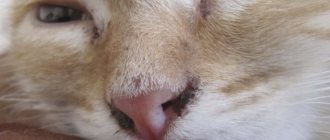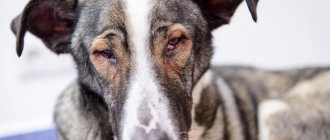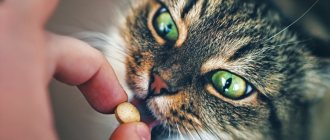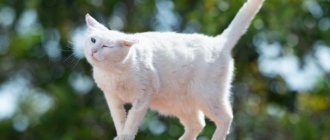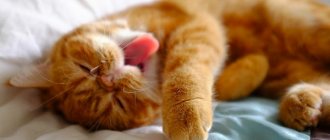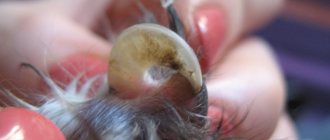Foaming at the mouth of a cat should be a reason to monitor your pet more closely. The causes of this phenomenon can be both harmless physiological phenomena and serious diseases. It is important to pay attention to the presence of accompanying symptoms in order to promptly contact a veterinary clinic if necessary.
Common Causes
In order for a veterinarian to correctly diagnose an animal, he must know the exact picture of what happened.
Physiological reasons:
- If a cat produces foam mixed with fur, this is an indication that she swallowed her own hairs while she was licking her hair. This is especially true for long-haired pets.
- When the owner observes white foam that appears once, then there is no need to panic in this case. This means that the animal currently has an empty stomach. That is, the food has already passed into the intestines, but gastric juice remains in the stomach, which irritates the gastric mucosa. As a result, mucus is released, which mixes with air and gastric juice, and leaves the pet’s body in the form of foam.
- A pregnant cat may secrete yellowish foam, which may or may not be mixed with food. It usually goes away after the animal eats or sleeps.
- There are cases when increased salivation caused by a pet's nervous shock can cause foaming in the corners of the mouth.
Problems in the gastrodigestive area and in the oral cavity:
- If, along with the foam coming out of the cat’s mouth, green vomit is released, then this is a sign that food from the intestines has entered the stomach. Also, in addition to food, there is also bile in the stomach. In this situation, it is better to contact a veterinarian to find out the animal’s condition, because this may be a sign that the cat has recently eaten grass. Or perhaps this is a symptom of a rather serious digestive tract infection.
- If a cat foams with blood, then you need to pay attention to the color of the blood. When the blood is bright red, it is a sign of bleeding in the esophagus. The cause may be either the presence of a foreign object, or an injury received, for example, from a bone. When brown blood is released, this is a sign of gastritis, stomach ulcers, and liver diseases.
- Foaming may be an indicator of oral disease. At this time, profuse salivation also occurs. This process can be determined by visual inspection of the animal. Usually, during stomatitis, a lot of saliva appears in the kitten’s mouth, which turns into foam under the influence of air.
Foaming in the corners of the mouth, as an indicator of the severity of the cause:
- Foam at the corners of the mouth is not always a sign of a harmless indigestion; it can often be a harbinger of a serious illness, such as distemper. In the presence of this serious illness, in addition to foam secretions, the cat drools, and there are no foreign masses, that is, there is no food or hair. Drooling and foam are released quite often; in this case, the cat’s condition does not improve; on the contrary, it only gets worse. If the owner discovers such a condition, then you need to immediately contact a veterinarian, otherwise there may be a quick death.
- Foamy discharge may be a sign of epilepsy in a cat. As a rule, convulsions are also observed at this time. In this case, consultation with a specialist is necessary.
- Foaming can cause severe poisoning in a pet, at which time he has a shaky gait, constant vomiting, and loose stools. These symptoms require immediate consultation with a veterinarian.
Causes of foam and increased salivation in cats
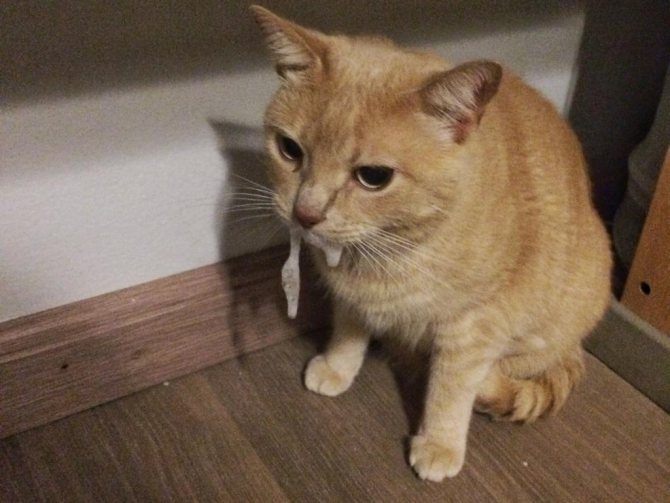
Foaming from the mouth of a four-legged pet is usually associated with excessive saliva production. Often the causes of foamy vomiting are quite harmless, and it will not be difficult to identify them yourself at home. However, sometimes such a problem can arise due to a factor that seriously threatens the health and life of the pet. Pathological causes of foam coming out of the mouth in a cat must be promptly identified and eliminated.
Toxicosis during pregnancy
Like women, cats experience toxicosis during pregnancy. This painful condition is often accompanied by foam at the mouth. Typically, a pregnant pet produces foamy drool after eating or sleeping. If this happens after feeding, the stomach contents expelled by the cat may contain pieces of incompletely digested food. The awakened expectant mother vomits transparent foam. This is a normal phenomenon and does not require special measures. When the pet's toxicosis ends, it will disappear by itself.
First aid
Naturally, if your pet’s condition causes any danger, then it is better to contact a veterinarian, but it is also necessary to promptly provide the correct assistance to the cat:
- If the owner is sure that the cause of the malaise is the hair that has gotten inside, then for a better release of the hairball, the cat can be given one teaspoon of Vaseline oil.
- For diseases in the oral cavity, the veterinarian prescribes antiseptic drugs, ointments and antibiotics.
- If a kitten shows signs of poisoning on its face, then you need to urgently contact a veterinarian and give it absorbents, for example, activated carbon, polysorb, polyphepan.
- When a kitten experiences convulsions, it needs to be placed on a flat surface. The head must be firmly fixed to one side, this is necessary so that the animal does not suffocate from vomit. Use a spoon to remove your pet's tongue.
Video “Poisoning in a cat: Vet Academy”
Was this article helpful?
Thank you for your opinion!
The article was useful. Please share the information with your friends.
Yes (80.00%)
No (20.00%)
X
Please write what is wrong and leave recommendations on the article
Cancel reply
Rate the usefulness of the article: Rate the author ( 15 votes, average: 4.20 out of 5)
Discuss the article:
Prevention
It is always easier to prevent a disease than to treat it later, so to maintain your pet’s health you need to follow simple preventive measures:
- To prevent foam from appearing in the corners of the mouth, you need to regularly brush your pet's fur.
- The cat's food should have a fairly soft consistency. If your pet eats bones, you need to make sure that they do not injure the mucous membranes of the mouth, esophagus and stomach.
- Regular use of anthelmintic drugs will help avoid this problem, since sometimes a large accumulation of parasites leads to foamy discharge in the kitten.
- It is necessary to do regular medical examinations, which will help to notice the impending danger and begin timely treatment.
- It is necessary to monitor what your pet eats. If your cat is walking outside, you can hang a bell around its neck to prevent the possibility of poisoning from a sick mouse or bird.
- You need to buy food and medicine in specialized places, because there are currently many counterfeits on the market that can lead to a similar problem.
Regular examination and proper care of the animal will help to avoid such troubles, which frighten not only the owner, but also the pet.
Diagnosis and treatment
When contacting a veterinary clinic, you need to provide the specialist with the following information:
- What did the cat feed, were there any changes in the diet.
- How often did vomiting occur?
- Are there any chronic diseases or infections in the animal that the owner is aware of?
This will help establish an accurate diagnosis and take the necessary measures.
Diagnosis of the pathological condition of a cat is as follows:
- analysis of the type and consistency of vomit;
- examination of the cat, analysis of the general condition;
- laboratory tests of blood, urine;
- Ultrasound of the abdominal cavity, kidneys.
The treatment regimen is selected depending on the established diagnosis. It includes drug therapy and measures to prevent dehydration.
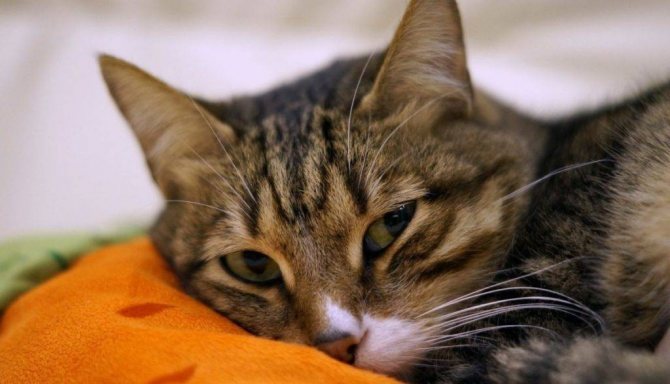
During the treatment of vomiting in a cat, a special diet is necessary. Food should be semi-liquid. Feed your pet more often, in small portions. Meat should only be given boiled and chopped. After stabilization of the condition, the transition to the usual diet should be gradual.
Questions from a veterinarian to help make a diagnosis:
- diet for the entire time, over the last 2 days, were there any changes;
- presence of appetite;
- amount of vomit, what it consists of;
- chronic diseases.
Take the following tests:
- biochemical analysis of blood and urine;
- Ultrasound to analyze intestinal integrity;
- x-ray to exclude tumors and foreign objects;
- stool analysis for worms.
To understand what actually caused the vomiting, the doctor must find out some details from the owner:
- When the vomiting started.
- What has the cat been eating lately? Have there been any changes in his diet? How much did he eat?
- How often does vomiting occur?
- How much vomit comes out and its composition.
- Does the cat have any chronic or infectious diseases?
- How the animal eats and drinks.
- Cat behavior.
- Frequency of going to the toilet.
In addition, the doctor must examine the animal. Sometimes, to make a diagnosis, it is enough to obtain information from the pet owner and palpate the abdomen. If this is not enough, the doctor will order a urine and blood test.
Some clinics prefer to do a full range of diagnostic measures, which includes x-rays of the kidneys and ultrasound of the abdominal cavity.
Treatment depends entirely on the diagnosis. Mostly medications are prescribed, as well as measures aimed at preventing dehydration.
There are several treatment methods:
- If vomiting is caused by a malnutrition, then a change in diet and medications that restore the intestinal microflora will be prescribed.
- For gastritis, medications are also prescribed to help restore digestion.
- If the doctor discovers that the cat is infected with worms, then in addition to restoring the water-salt balance, antiparasitic drugs will be prescribed.
- In case of poisoning, the cat's stomach will be rinsed and appropriate medications will be prescribed to help remove toxins from the body.
- If vomiting is associated with a respiratory disease or with an inflammatory process, then the cause of vomiting will also be treated first.
- Frequent vomiting during pregnancy also requires therapeutic measures. Usually the animal is given IV drips with glucose and vitamins to support the body of the expectant mother and her unborn kittens.
- In case of renal failure, first of all, they try to normalize the functioning of this organ. To do this, the cat is put on a low-protein diet and prescribed medications that lower blood pressure.
- Vomiting during estrus is not treated, but only medications are prescribed to prevent the animal from dehydration. If a cat undergoes such a period and is constantly accompanied by vomiting and diarrhea, the veterinarian may suggest sterilization to save the animal from suffering and possible negative consequences.
The treatment strategy is to eliminate not only the signs of pathology, but also its causes. Therefore, the cat owner must understand in what cases and how he can help the cat on his own, and when it is necessary to immediately seek help.
What should a breeder do?
If the cat owner is absolutely sure that the foam is the result of his incorrect administration of the drug, then there is no reason to panic. Also, don’t worry, just adjust the feeding regime when foamy discharge is a consequence of the cat’s prolonged fasting.
Almost every pet owner has encountered the problem of their cat foaming at the mouth. In this case, it is advisable to independently determine the cause of this symptom, as this will help to correctly provide first aid even before the cat is examined by a veterinarian. Why foam occurs and how to help your pet can be found in this article.
Contacting a veterinarian
You should seek help from a veterinarian when your cat has:
- regular foamy discharge from the mouth;
- severe vomiting, convulsions, elevated body temperature, eyes become white or cloudy;
- strong changes in the animal’s behavior were noticeable, which was not typical for her.
When a deterioration in the health of a pet is noticed, the main thing is not to do anything until the doctor arrives, especially not to give any medications, because they can greatly change the overall picture of what is happening and not always for the better.
By following all the recommendations and warnings, in most cases the animal can be cured as soon as possible.
Foam after giving medicine: is it necessary to panic?
Inept giving of tablets, drops in the mouth or suspension by the breeder himself in almost 100% of cases provokes foamy, profuse discharge from the mouth. This is explained by the effect of a bitter taste on the taste buds and thus the cat tries to get rid of the medicine that has entered the oral cavity.
The worst that can happen is that the required amount of the drug does not enter the body and the effect will be insignificant or absent. Therefore, if the owner is not confident in his dexterity, it is better to bring the cat to a veterinary clinic or call a doctor at home by phone, around the clock.
Can vomiting be prevented?
To prevent vomiting you need to:
- periodically treat the cat for worms;
- balance the diet;
- think over the feeding regime;
- undergo a preventive veterinary examination annually and undergo routine vaccinations against infections.
If vomiting is caused by the accumulation of wool in the stomach, then special foods or pastes will help speed up its removal from the digestive tract.
It will not be possible to prevent the ingestion of wool, but you can reduce its entry into the stomach. This can be done with the help of combs, mitten brushes, and furminators.
This is interesting: What causes kidney disease in cats?
Poisoning by poisonous plants
A cat, in search of the vitamins it needs, can chew any plant in the house or on the street. But among the many indoor flowers and garden plants planted in flowerpots, flower beds and growing freely on the site, there are also poisonous for pets, causing poisoning. Even Kalanchoe, a completely harmless flower, can have a negative impact on a pet’s heart, let alone plants that are more dangerous for a cat.
Common signs of poisoning by poisonous plants include:
- arrhythmia and rapid pulse;
- dilation or constriction of the pupils;
- diarrhea;
- trembling in the body.
What can be done in case of plant poisoning? You should immediately rinse your pet’s stomach with a weak solution of potassium permanganate or enterosgel (about 1 tablespoon).
Cases of poisoning in cats, despite all their caution, are not so rare. And most of the blame for what happened to pets rests, of course, on the owners of the animals. You must always follow the instructions when treating cats for parasites, isolate your pets in another room when baiting bedbugs with dichlorvos, put away all household chemicals, and do not give your pets expired food, spoiled food or mushrooms, the edibility of which is in doubt.
(Don't forget to confirm your subscription by clicking on the link in the letter sent to the specified e-mail.)
This article was prompted by a recent incident. My Chupacabra really loves grass, a special green grass that is sold in pet stores. And then one day I bought him the wrong grass.
Although, it would seem, how can a pet store sell some kind of different herb!
In the evening, Chupacabra was gnawing grass with pleasure, and at night strange sounds were heard. And in the morning I discovered several strange puddles on the floor - the Chupacabra was vomiting at night.
But since we are all accustomed to the fact that cats spit up their fur from time to time, especially if they are fluffy, I did not pay attention to this. And she went to work. And in the evening I found several more caustic puddles on the floor and a completely exhausted Chupacabra lying on the bed like a rag. The cat was clearly poisoned. But what could he have poisoned himself with?
Naturally, the newly acquired weed went into the trash, and the Chupacabra still had to be treated for several days. No one could have expected such a situation from simple cat grass.
Gastritis or injury?
Foaming mixed with blood can be caused by:
- Injuries (caused by bones or other sharp and hard components of the cat’s diet);
- entry of a foreign object into the esophagus;
- stomach ulcers;
- intestinal perforation;
- gastritis;
- liver diseases.
You can independently determine the cause by the color of the blood. Red and bright red - indicate the first two possible reasons; brown – about the latest factors. Spots of scarlet blood indicate bleeding in the throat or esophagus, and clots indicate problems in the stomach area. Bloody threads are often the result of a bone stuck in the throat and scratched. In any case, such a phenomenon should not go unnoticed, and the cat should be taken to a veterinary clinic.
We suggest you read: Worms in calves, symptoms, treatment

